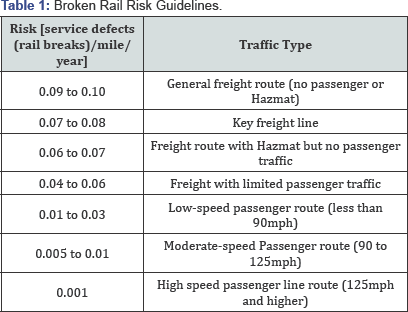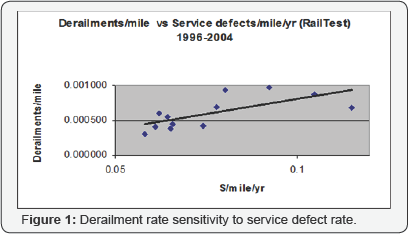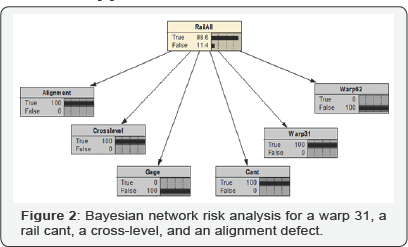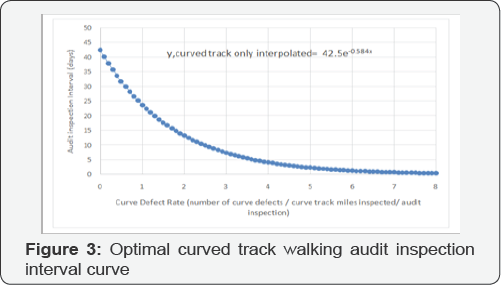Improving Railroad Safety with Risk Management-Juniper Publishers
Juniper Publishers -Journal of Civil Engineering
Perspective
Railroad safety and the prevention of derailments
remain a major concern of railroads worldwide. As railroads continue to
work to reduce derailments, a new generation of innovative risk
management techniques have been introduced to help railroads locate and
identify potential derailment sites as well as improve inspection
procedures and schedules [1-5].
These new techniques focus on the derailment causes them and develop
specific risk management tools that quantify and analyze the "risk" for
each key derailment or accident area. This has led to the development of
risk based tools to identify high risk locations in the track and
provide guidance for improved inspection and/or preventive maintenance
to reduce that level of risk.
For example, track caused derailments represent one
of the largest derailment categories both in US and worldwide. In the
US, it represents approximately 30% of all FRA reported derailments. The
major failure types identified under the track caused derailment
category are: broken rails, track geometry, turnouts and roadbed. In
each of these cause areas, research has resulted in new risk based tools
aimed at helping maintenance officers pinpoint potential derailment
location and take action to reduce the risk of a derailment. These
include risk based tools that look at:
i. Broken rail risk; to quantify the risk of
occurrence of a broken rail/broken rail derailment with a focus on
adjusting ultrasonic test schedules to reduce that risk [4,6].
ii. Risk based scheduling of track safety audit
inspections to optimize safety audit inspections, particularly on high
speed or high density track [5].
iii. Track geometry defect risk; to quantify the risk
of occurrence of a critical geometry defect (FRA violation) with a
focus on adjusting track geometry car test schedules to reduce that risk
[1,2].
iv. Inter-relation between track geometry defects and
the development of rail defects that increase the risk of a rail defect
developing at a given location [7,8].
v. Vehicle/track geometry risk; to identify and
prioritize locations with track geometry conditions that have a high
potential for vehicle/track geometry related derailments [9].
vi. Turnout condition; to quantify the condition of a switch (turnout) based on the potential for derailment [10].
vii. Track buckling risk; to identify and prioritize
locations of high potential buckling risk for follow up maintenance
action [11].


For example, broken rail risk management includes using service defect rate to determine allowable levels of risk (Table 1)
and determine ultrasonic rail test schedules. While service defects
represent only about 10% of all defects, they have a very strong
correlation to derailment occurrence, as shown in Figure 1.
Recent studies indicate that a broken rail derailment occurs
approximately every 133 service defects for a derailment per service
defect rate of 0.0075 [6].
As such they form the basis for a risk based scheduling methodology as
described in References 4 and 6. Actual implementation of this risk
based scheduling approach has shown a very well defined reduction in
derailments [6].

A further application of risk management calculates
the probability that a site with one or more geometry defects will
develop a rail defect [7,8]. This is illustrated in Figure 2
where a Bayesian model calculated an 88.6% probability of rail defect
developing at the site with multiple track geometry defects over a
period of five years.
Yet another risk management application is for the
determination of when and where to conduct safety audit inspections.
This risk management approach process first establishes an acceptable
level of risk for having a safety violation in a given territory, and
then taking into account defect history and real-time track conditions,
schedules audit inspections based on those conditions. Figure 3 illustrates
the risk based audit inspection approach, where the frequency of audits
is directly related to the level of defects found in previous
inspections. The other referenced approaches follow the same principal
i. Defining a relationship between the risk sensitive parameters and safety as defined here by occurrence of derailments (Figure 1).
ii. Quantifying the relationship (Figure 2).
iii. Quantifying the level of risk acceptable under a range of operating conditions (Table 1).

iv. Developing a relationship between risk parameter and inspection/other action to reduce risk and improve safety (Figure 3).
As can be seen, a new generation of track safety
management tools has been developed to quantify and analyze the "risk"
associated with key track failure modes. These risk based assessment
tools have been shown to contribute directly to a reduction in track
failures through their ability to selectively identify high risk
locations and bring remedial action to bear on these identified
locations. The model classes presented here all rely on research that
has been developed over the last several decades, and are designed to be
used in large-scale applications, to identify potential failure sites
across an entire route or railway system.
The results have been clear and impressive. Use of
risk-based test scheduling techniques reduces the risk of derailments.
For example, in the case of broken rail derailments, use of risk based
assessment and rail test scheduling to determine optimum rail test
intervals, has resulted in a reduction in the rate of broken rails and
broken rail derailments by 30% or more on several major US railroads.
i. Broken rail risk; to quantify the risk of
occurrence of a broken rail/broken rail derailment with a focus on
adjusting ultrasonic test schedules to reduce that risk [4,6].
ii. Risk based scheduling of track safety audit
inspections to optimize safety audit inspections, particularly on high
speed or high density track [5].
iii. Track geometry defect risk; to quantify the risk
of occurrence of a critical geometry defect (FRA violation) with a
focus on adjusting track geometry car test schedules to reduce that risk
[1,2].
iv. Inter-relation between track geometry defects and
the development of rail defects that increase the risk of a rail defect
developing at a given location [7,8].
v. Vehicle/track geometry risk; to identify and
prioritize locations with track geometry conditions that have a high
potential for vehicle/track geometry related derailments [9].
vi. Turnout condition; to quantify the condition of a switch (turnout) based on the potential for derailment [10].
vii. Track buckling risk; to identify and prioritize
locations of high potential buckling risk for follow up maintenance
action [11].






Comments
Post a Comment